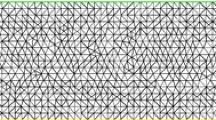Abstract
In this paper the performance of various stabilized mixed finite element methods based on the lowest equal-order polynomial pairs (i.e., P 1 − P 1 or Q 1 − Q 1) are numerically investigated for the stationary Stokes equations: penalty, regular, multiscale enrichment, and local Gauss integration methods. Comparisons between them will be carried out in terms of the critical factors: stabilization parameters, convergence rates, consistence, and mesh effects. It is numerically drawn that the local Gauss integration method is a favorite method among these methods.
Similar content being viewed by others
References
Araya R, Barrenechea GR, Valentin F (2006) Stabilized finite element methods based on multiscale enrichment for the Stokes problem. SIAM J Numer Anal 44: 322–348
Baiocchi C, Brezzi F (1992) Stabilization of unstable numerical methods. Proc. Problemi attuali dell analisi e della fisica matematica, Taormina, pp 59–64
Bochev P, Dohrmann C (2006) A computational study of stabilized, low-order C 0 finite element approximations of Darcy equations. Comput Mech 38: 323–333
Bochev P, Dohrmann C, Gunzburger M (2006) Stabilization of low-order mixed finite elements for the Stokes equations. SIAM J Numer Anal 44: 82–101
Bochev P, Gunzburger M (2004) An absolutely stable pressure-Poisson stabilized finite element method for the Stokes equations. SIAM J Numer Anal 42: 1189–1207
Bochev P, Lehoucq R (2006) Regularization and stabilization of discrete saddle-point variational problems. Electron Trans Numer Anal 22: 97–113
Brefort B, Ghidaglia JM, Temam R (1988) Attractor for the penalty Navier-Stokes equations. SIAM J Math Anal 19: 1–21
Brezzi F, Douglas J Jr (1988) Stabilized mixed methods for the Stokes problem. Numer Math 53: 225–235
Buscagliaa GC, Basombrio FG, Codinab R (2000) Fourier analysis of an equal-order incompressible flow solver stabilized by pressure gradient projection. Int J Numer Method Fluids 34: 65–92
Chen Z (1993) Projection finite element methods for semiconductor device equations. Comput Math Appl 25: 81–88
Chen Z (2005) Finite element methods and their applications. Springer-Verlag, Heidelberg
Ciarlet PG (1978) The finite element method for elliptic problems. North-Holland, Amsterdam
Dohrmann C, Bochev P (2004) A stabilized finite element method for the Stokes problem based on polynomial pressure projections. Int J Numer Method Fluids 46: 183–201
Douglas J Jr, Wang J (1989) An absolutely stabilized finite element method for the Stokes problem. Math Comput 52: 495–508
Falk R (1975) An analysis of the penalty method and extrapolation for the stationary Stokes equations. In: Vichnevetsky R (ed) Advances in computer methods for partial differential equations. AICA, pp 66–69
Gerdes K, Schöktza D (1999) hp-Finite element simulations for Stokes flow-stable and stabilized. Finite Elem Anal Des 33: 143–165
Girault V, Raviart PA (1987) Finite element method for Navier-Stokes equations: theory and algorithms. Springer-Verlag, Berlin
Harari I, Magoules F (2004) Numerical investigations of stabilized finite element computations for acoustics. Wave Motion 39: 339–349
Hecht F, Píronneau O, Hyaric AL, Ohtsuka K (2007) Freefem++ manual. Laboratoire Jacques Louis Lions
Hughes TJR, Franca LP, Balestra M (1986) A new finite element formulation for computational fluid dynamics: V. Circumventing the Babuska-Brezzi condition: a stable Petrov-Galerkin formulation of the Stokes problem accommodating equal-order interpolations. Comput Methods Appl Mech Eng 59: 85–99
Hughes TJR, Franca LP, Hulbert GM (1989) A new finite element formulation for computational fluid dynamics: VIII. The Galerkin/least-squares method for advective-diffusive equations. Comput Methods Appl Mech Eng 73: 173–189
Li J, Chen Z (2008) A new local stabilized nonconforming finite element method for the Stokes equations. Computing 82: 157–170
Li J, Chen Z (2009) A new stabilized finite volume method for the stationary Stokes equations. Adv Comput Math 30: 141–152
Li J, He Y (2008) A stabilized finite element method based on two local Gauss integrations for the Stokes equations. J Comput Appl Math 214: 58–65
Li J, He Y, Chen Z (2007) A new stabilized finite element method for the transient Navier-Stokes equations. Comput Methods Appl Mech Eng 197: 22–35
Li J, Mei L, He Y (2006) A pressure-Poisson stabilized finite element method for the non-stationary Stokes equations to circumvent the inf-sup condition. Appl Math Comput 1: 24–35
Rannacher R, Turek S (1992) Simple nonconforming quadrilateral Stokes element. Numer Methods Partial Differ Equ 8: 97–111
Silvester DJ (1994) Optimal low-order finite element methods for incompressible flow. Comput Methods Appl Mech Eng 111: 57–368
Silvester DJ (1995) Stabilised mixed finite element methods. Numerical Analysis Report No. 262
Silvester DJ, Kechkar N (1990) Stabilized bilinear-constant velocity-pressure finite elements for the conjugate gradient solution of the Stokes problem. Comput Methods Appl Mech Eng 79: 71–86
Temam R (1983) Navier-Stokes equations, theory and numerical analysis, 3rd edn. North-Holland, Amsterdam
Author information
Authors and Affiliations
Corresponding author
Additional information
Communicated by W. Hackbusch.
This research was subsidized by the NSF of China 10701001, 10671154, the National Basic Research Program (No. 2005CB321703), and the Natural Science Basic Research Plan in Shaanxi Province of China (No. SJ08A14) and by the US National Science Foundation grant DMS-0609995 and CMG Chair Funds in Reservoir Simulation.
Rights and permissions
About this article
Cite this article
Li, J., He, Y. & Chen, Z. Performance of several stabilized finite element methods for the Stokes equations based on the lowest equal-order pairs. Computing 86, 37–51 (2009). https://doi.org/10.1007/s00607-009-0064-5
Received:
Accepted:
Published:
Issue Date:
DOI: https://doi.org/10.1007/s00607-009-0064-5
Keywords
- Stokes equations
- inf-sup Condition
- Stabilized methods
- Conforming finite element
- Nonconforming finite element
- Mixed methods
- Numerical results




